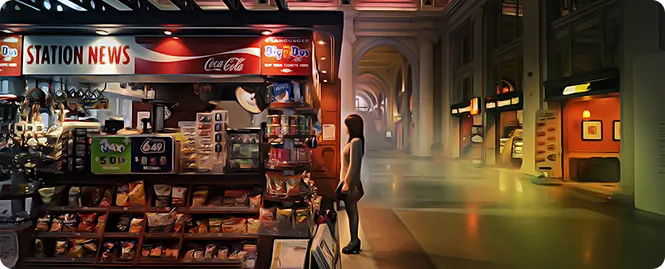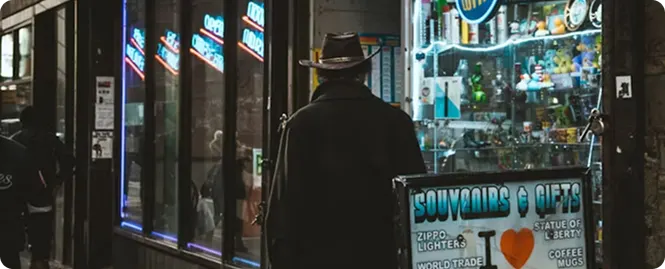Why Are Convenience Stores Easy Targets for Robbery?
Table of Contents
Key Takeaways
-
Convenience stores handle high cash flow from daily transactions, making them vulnerable to robbery risks and increasing robbery rates.
-
Late-night and 24/7 operations, combined with minimal security measures, create ideal conditions for potential robbers.
-
Isolated store locations and open layouts expose cash registers and staff to direct threats.
-
High traffic with low staffing levels hinders effective monitoring and rapid response during criminal incidents.
-
Comprehensive prevention measures enable convenience store owners to counter the factors contributing to robberies in their stores effectively.
Convenience stores, popular and frequently visited by residents, handle vast amounts of cash daily through numerous transactions. Whether at registers, fuel pumps, or kiosks, these businesses process significant sums of money, making them service hubs and potential targets for crime. The constant cash flow creates an environment where overflowing registers become clear signals of potential threats, increasing vulnerability to robberies.
The cash-heavy nature of convenience stores attracts potential robbers seeking rapid gains and quick profits. Criminals target these stores because of the easy availability of cash, minimal security protocols, and the promise of swift, lucrative returns from a single successful heist. Furthermore, the repetitive pattern of large cash flow during peak business hours further increases the risk, leaving stores vulnerable to criminal activities. In this blog, we'll see why convenience stores are easy targets.
High Cash Flow and Quick Transactions
High cash flow defines many convenience stores as they handle constant monetary exchanges throughout the day. These businesses often see significant amounts of cash at registers, requiring quick processing. The rapid turnover in transactions contributes to an environment where cash on hand becomes a focal point for security risks, notably.
The heavy cash on hand in convenience stores makes them appealing targets for potential robbers. Criminals are drawn to swift transactions and high liquidity, which enable them to obtain quick returns. This attraction is a primary factor driving robbery factors for these stores, as perpetrators exploit fast-paced cash exchanges effectively.

Late-Night and 24/7 Operations
Operating during late-night hours or around the clock exposes stores to a wide range of risks. With reduced staff presence and lower visibility, these establishments become pretty isolated. Not having immediate support during off-peak hours contributes to an increase in security risks, making late-night operations a serious factor in convenience store robberies.
Criminals target convenience stores during late-night and 24/7 shifts due to diminished staff and isolation. With fewer security measures like security cameras and alarms monitored, robbers find these hours opportune. The scattered presence of employees creates an environment where law enforcement response may be delayed, increasing the risk of violence.

Minimal Security Measures
Many convenience stores lack robust security measures, leaving them vulnerable. The absence of advanced systems such as security cameras, alarms, and on-site personnel heightens their exposure to crime. Without adequate preventive measures, these stores become easy targets for potential robbers, significantly increasing the risk of theft and other security threats.
Stores with minimal security measures are particularly susceptible to break-ins and armed robberies. The lack of continuous monitoring and quick-response security systems exposes cash registers and employees to danger. This vulnerability, together with outdated infrastructure, heightens robbery risks and contributes to increasing rates of violent crimes targeting convenience store locations.

Small and Isolated Locations
Due to remoteness and poor lighting, convenience stores in small, isolated locations face heightened risks. Limited nearby businesses and minimal foot traffic reduce natural surveillance. These factors, combined with a challenging store location, contribute to an increased risk of robbery, making it easier for criminals to strike without immediate detection.
Stores operating in isolated areas, with limited neighboring businesses, are more vulnerable to criminal activities. The lack of community oversight and immediate law enforcement presence increases the likelihood of successful robberies. Such locations often lack adequate security cameras, further amplifying convenience store robbery risks and making preventative measures more challenging.

High Traffic but Low Staff Presence
High customer traffic can distract staff from maintaining stringent security protocols during peak hours. Focusing on serving numerous patrons often leads to reduced vigilance at cash registers and entry points. As a result, the abundance of shoppers can provide cover for criminal activities, notably increasing risks for robberies at convenience stores.
Managing large crowds with limited staffing poses significant challenges for convenience store owners. With fewer employees to monitor customers, opportunities for theft or robbery multiply. The strain on available personnel hampers effective security measures, ultimately heightening both robbery rates and the overall risk of workplace violence in such environments significantly.

Lack of Physical Barriers
Many convenience stores feature open layouts that provide minimal physical separation between employees and customers. This design often leaves cash registers and service counters unprotected, exposing staff to direct contact with potential robbers. The lack of physical barriers can facilitate quick, unnoticed access to cash and valuables during criminal incidents.
Cashiers and cash registers remain highly exposed to attacks without proper protective barriers. The absence of secure partitions and reinforced counters makes it easier for criminals to approach and compromise safety. This vulnerability forces convenience store owners to reconsider their security measures and invest in improved prevention strategies promptly today.

Increased Focus on Quick, Small-Scale Thefts
Convenience stores frequently experience quick, small-scale thefts involving items such as cigarettes, alcohol, and snacks. The low cost and high resale value of these products make them attractive to thieves. Criminals often exploit these opportunities to commit rapid thefts, adding to overall convenience store robbery risks and economic losses consistently.
The simplicity of stealing easily resalable items drives criminals to target convenience stores. Items with high turnover and minimal tracking are quickly snatched, resulting in cash gains. This ease of acquisition reinforces theft patterns, forcing store owners to enhance prevention measures and train employees to recognize and thwart robbery attempts.

Employee and Customer Vulnerability
Robbery incidents in convenience stores place both employees and customers at considerable risk. The sudden threat of armed robbery creates a dangerous environment where staff and patrons may face harm. Exposure to violent crimes increases the overall risk of workplace violence, leaving individuals vulnerable during high-stress situations with little warning.
The emotional and physical impact of robberies on staff and bystanders can be profound. Traumatic experiences, coupled with financial losses, disrupt daily operations and create long-term stress. This exposure to direct harm underscores the urgent need for enhanced security measures and thorough training programs for all convenience store employees.

Limited Ability to Track Repeat Offenders
Many convenience stores struggle to track repeat offenders effectively because of inconsistent security footage and limited technological resources. The sporadic nature of captured evidence hampers efforts to identify criminals accurately. This challenge significantly undermines law enforcement investigations and leaves establishments more susceptible to recurring convenience store robberies across various locations.
Robbers often target the same convenience store repeatedly, exploiting weaknesses in security protocols. Frequent break-ins at identical locations highlight the persistent nature of this threat. The inability to deter repeat offenders through effective surveillance and swift law enforcement responses further exacerbates the risks of the store’s robbery and associated security risks.

Conclusion
In summary, convenience stores are easy targets for robbery due to high cash flow, late-night operations, and minimal security measures. Isolated locations and open layouts further expose vulnerabilities. The combination of these factors creates an environment where potential robbers can exploit weaknesses, driving up robbery rates and risk of violence.
Given the multifaceted challenges, comprehensive insurance is vital for convenience store owners. Robust coverage and risk management strategies protect businesses against unexpected incidents, ensuring long-term stability with confidence despite high convenience store robbery risks and potential violent crimes. Insure C-Store offers tailored solutions to reduce financial losses resulting from robberies.

